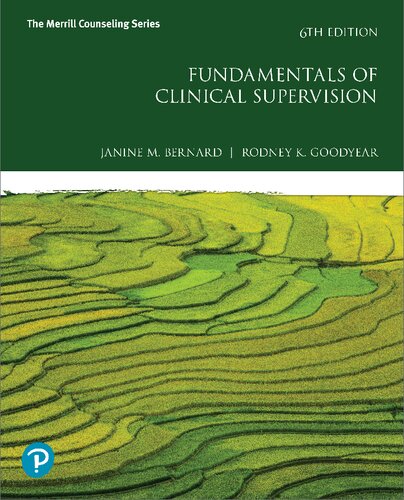Description
Fundamentals of Clinical Supervision 6th Edition by Janine M. Bernard, ISBN-13: 978-0134752518
[PDF eBook eTextbook] – Available Instantly
- Publisher: Pearson; 6th edition (January 12, 2018)
- Language: English
- 448 pages
- ISBN-10: 0134752511
- ISBN-13: 978-0134752518
The standard for clinical supervision.
Fundamentals of Clinical Supervision, 6th Edition offers a comprehensive, interdisciplinary approach that makes it the most highly cited publication in the field and an authoritative resource for anyone seeking certification as an Approved Clinical Supervisor. Readers gain a thorough view of clinical supervision as they explore central themes from a variety of mental health professions, as well as the important topics of supervision models and modalities, administrative issues, and professional concerns.
Retaining its accessible style, the 6th Edition includes additional coverage of multicultural supervision and competence, emerging supervision models, use of technology in supervision, new sections on group work and ethics, increased attention to client outcomes, and a significant focus on supervision beyond training. A new appendix includes supervision examples to help readers connect theory to practice. Its one-of-a-kind supervision toolbox, scholarly approach, and thorough topic coverage sets Fundamentals of Clinical Supervision apart.
Table of Contents:
Preface
New to this Edition
Organization of the Sixth Edition
Brief Contents
Contents
Part I Introduction and General Approaches to Supervision
Chapter 1 Introduction to Clinical Supervision
Foundational Premises
Terminology
Supervision’s Importance to the Professions
Supervision’s Importance to Regulatory Boards
Supervision’s Importance to Credentialing that Professional Organizations Provide
Supervision’s Importance to Program Accreditation
Supervisee Competence As a Goal
Supervised Practice: The Pathway to Competence
The Importance of Supervisor Competence
Defining Supervision
Differentiating Supervision from Overlapping Functions
Teaching versus Supervision
Counseling or Therapy versus Supervision
Consultation versus Supervision
Typically a Member of the Same Profession
Supervision is Evaluative and Hierarchical
Supervision Extends over Time
Supervisors’ Functions
Supervisor Functions in All Supervision
Supervisor Functions in Some Supervision
Supervisees’ perceptions of supervision
A Conceptual Framework for Supervision
Parameters of Supervision
Supervisee Developmental Level
Supervisor Tasks
Using the Framework
Conclusion
Chapter 2 Supervision Models: Psychotherapy-Based and Developmental Models
Psychotherapy-Based Models of Supervision
Psychodynamic Supervision
Humanistic–Relationship Oriented Supervision
Cognitive–Behavioral Supervision
Systemic Supervision
Feminist Supervision
Postmodern/Constructivist Supervision
Narrative Supervision
Solution-Focused Supervision
Integrative Supervision
Conclusions about Psychotherapy-Based Supervision Models
Developmental Approaches to Supervision
The Loganbill, Hardy, and Delworth Model
The Integrated Developmental Model
Level 1
Level 2
Level 3
The Systemic Cognitive–Developmental Supervision Model
Reflective Developmental Models
Research on Supervisee Development
Cognitive Complexity and Cognitive Development.
Experience as an Indicator of Developmental Level.
Supervision Environment
Implications of Research
Conclusions about Developmental Models
Conclusion
Chapter 3 Supervision Models: Process Models and Second-Generation Models
Supervision Process Models
The Discrimination Model
Styles versus Roles
The Critical Events in Supervision Model
The Hawkins and Shohet Model
The Systems Approach to Supervision Model
Relationship
The Supervisor and Supervisee
Contextual Dimensions of Supervision
Supervisory Process Dimensions
Conclusions about Supervision Process Models
Second-Generation Models of Supervision
Combined Models
Pearson (2006)
The Transtheoretical Model of Clinical Supervision
Experiential Processes
Behavioral Processes
Gaete and Ness (2015)
Conclusions about Combined Models
Target Issue Models
The Synergistic Model for Multicultural Supervision
The Attachment-Caregiving Model of Supervision
Attachment System Activation
Safe Haven
Attachment System Deactivation
Secure Base
Competence/Learning
Integrative Spiritual Development Model
Concrete and Graduated Orientation
Interpersonal Assessment and Personally Relevant Application
Skill Development
Guided Reflection and Integration
Supportive Collaborative Feedback
Mentoring/Continuity and Follow-up
Conclusions about Target Issue Models
Common Factors Models
Lampropoulos (2002)
Morgan and Sprenkle (2007)
Domains and Supervision Activity
Dimensions of Supervision
Supervision Roles
Learning-Based Model of Psychotherapy Supervision
Alliance Building/Maintenance
Educational Interventions: The Cognitive Domain
Learning/Relearning: The Psychomotor Domain
Conclusions about Common Factors Models
Empirically Supported Supervision
Pulling it all Together
Conclusion
Part II Dimensions of the Supervision Relationship
Chapter 4 Supervisory Relationships: Triadic and Dyadic Systems
Supervision as a Three-Person System
Parallel Processes and Isomorphism
Parallel Process
Addressing Parallel Processes in Supervision
Research Concerning Parallel Processes
Concluding Comments about Parallel Processes
Isomorphism
Interpersonal Triangles
Interpersonal Triangles in Supervision
Supervision as a Two-Person System: The Working Alliance
Factors That Predict Effective Supervisory Alliances
Supervisor Factors Affecting Quality of Supervisory Alliance
Social Skills
Mindfulness
Supervisor Style
The Supervisor’s Use of Expert and Referent Power
The Supervisor’s Use of Self-Disclosure
The Supervisor’s Attachment Style
Multicultural Competence
Gender-Related Discrimination
The Supervisor’s (Un)Ethical Behavior
Supervisee Factors Affecting Quality of Supervisory Alliance
Openness to Experience and Extraversion
Supervisee Stress and Anxiety
Maladaptive Perfectionism Combined with Higher Counseling Self-efficacy
Supervision Processes Affecting Quality of Supervisory Alliance
The Use of a Supervision Contract
Clear and Fairly Conducted Evaluation Practices
Discussions of Racial and Ethnic Differences
Interacting Racial Identity Levels
Supervisor–Supervisee Complementarity
The Supervisee’s Experience of Negative Supervision
Role Conflict and Ambiguity
Impacts of the Supervisory Alliance
Effects of Strong Alliances on Supervision-Related Outcomes
Supervisees’ Willingness to Disclose
Supervisees’ Satisfaction with Supervision
Supervisees’ Ratings of Supervision Outcomes
Effects of Strong Alliances on Therapy-Related Outcomes
Supervisees’ Alliances with Their Clients
Adherence to Treatment Protocols
Effects of Strong Alliances on the Supervisee
Managing Alliance Fluctuations: Addressing and Resolving Conflict
Conflict Origins and Type
Conflicts Arising from Miscommunications or Mismatched Expectations
Normative Conflicts
Conflicts Arising from Participants’ Interpersonal Dynamics
Cultural Ruptures
Preparing Supervisees to Address Alliance Ruptures
Conclusion
Chapter 5 Supervisory Relationships: Supervisee and Supervisor Factors
Supervisee Engagement
Supervisee Resistance
Level of Trust in the Supervisor
Level of Agreement with the Supervisor about Tasks and Goals
Supervisee Developmental Level
Supervisee Countertransference and Parallel Processes
Supervisor Style
Supervisor Focus
Summary Comments about Supervisee Resistance
Supervisee Attachment
Supervisee Shame
Supervisee Responses to Shame or the Threat of Shame
The Supervisor’s Role in Minimizing Supervisee Shame
Supervisee Anxiety
Effects of Anxiety on the Supervisee
Anxiety Affects Supervisee Learning
Anxiety Affects Supervisee Performance
Anxiety Affects Quality of Engagement with the Supervisor
Supervisor Management of Supervisee Anxiety
Role Induction
Normalizing Anxiety and Giving Permission to Make Mistakes
Optimizing Levels of Supervisor-Offered Support and Challenge
Supervisees’ Need to Feel and Appear Competent
Supervisee Transference
Implications for Supervisors
Supervisor Factors
Supervisor Attachment Style
Interpersonal Power
Social Influence Theory
An Interactional Perspective on Power
Implications for Supervisors
Supervisor Countertransference
Conclusion
Chapter 6 Multicultural Supervision
Four Dimensions to Which Multiculturally Competent Supervisors Attend
The Intrapersonal Dimension of Identity
An Interpersonal Dimension: Expectations, Bias, and Prejudice
An Interpersonal Dimension: Responding to Others’ Cultural Identity and Behavior
Acculturation
The Sociopolitical Dimension: Privilege, Oppression, and Institutionalized -isms
Working Multiculturally with Specific Populations
Supervision Multicultural Competence: Race and Ethnicity
Racial Identity Development
Racial Identity in Supervision
Ethnic Differences
Supervision Multicultural Competence: Gender
Different Voices
Differences between Male and Female Supervisors
Gender as a Variable Affecting Supervisee and Supervisor Evaluations and Satisfaction
Supervisors’ Evaluations of Supervisee Competence
Supervisees’ Evaluations of Supervisors
Supervisee Satisfaction
Supervisor Power
Supervision Multicultural Competence: Sexual Minority Status
Supervision Multicultural Competence: Religion and Spirituality
Religious Beliefs versus an LGBT-Affirmative Stance
Supervision Multicultural Competence: International Students
Supervision Multicultural Competence: Students with Disabilities
Supervision Multicultural Competence: Political Diversity
Training, Assessment, and Research in Multicultural Supervision
Pulling it All Together
Conclusion
Part III The Delivery of Clinical Supervision
Chapter 7 Organizing the Supervision Experience
The Importance of Competence in Organizing Supervision
The Role of Institutional Culture
The Essential Ingredient: A Supervision Plan
Contexts for Supervision: Two Different Worlds
The Graduate Program as Context for Supervision
The Field Site as Context for Supervision
Goals
Communication
Foundational Tasks for Organizing Supervision
Initial Communication between Graduate Program and Site
The Interview
Orientation
The Supervision Contract
The Supervisee Bill of Rights
Professional Disclosure Statements
Ongoing Organizational Tasks
Communication, Communication, Communication
Communication and Evaluation
Supervisor as Agency Representative
Managing Time
Time Management and Choosing Supervision Methods
Record Keeping
Planning for the Exceptions
Evaluation and Debriefing
Some Final Thoughts
Get Support
Know Yourself
Gather Resources
Get Feedback
Be Intentional
Conclusion
Chapter 8 Individual Supervision
Initial Criteria for Choosing Supervision Interventions
Structured Versus Unstructured Interventions
Methods, Forms, and Techniques of Supervision
Self-Report
Process Notes and Case Notes
Transcripts
Live Observation
Audio and Video Recordings
Using Video in Supervision
Picking a Video Camera
Video Recording on Mobile Devices
Ensuring Adequate Audio
Video Playback
Storing Digital Videos
Picture-in-Picture Video
Consent
How to Introduce Video to Clients
Planning Recording-Based Supervision
Issues Specific to Video Recordings
Routine Outcome Monitoring
Uses of Routine Outcome Measurement in Supervision
Implementation and Limits of Routine Outcome Measurement
Interpersonal Process Recall
Written Feedback
Methods to Stimulate and Teach Reflection
Socratic Questioning and Thinking Aloud
Journal Writing
Reflecting Teams
Other Strategies
Identifying and Responding to Personal Dilemmas
Reflecting on the Supervision Session
Nonlinear Supervision Strategies
Sandtray
Using Metaphor
Other Strategies
Supervision Using the Internet
Videoconferencing
E-mail and Text Chat Supervision
Legal, Regulatory, and Ethical Issues
Security
Timing of Supervision
Triadic Supervision
Benefits Associated with Triadic Supervision
Challenges Associated with Triadic Supervision
Methods for Conducting Triadic Supervision
Favorable Conditions for Triadic Supervision
Time Allotted
Choosing Pairs Carefully
Having a Distinct Role for the Nonpresenting Supervisee
Orienting Supervisees
Supplementing with Individual Supervision
Training Supervisors
Concluding Comments
Putting It All Together
Conclusion
Chapter 9 Group Supervision and Live Supervision
Group Supervision
Definition, Advantages, and Limitations of Group Supervision
Benefits and Limitations of Group Supervision
Benefits
Limitations
Group Supervision: A Unique Blend of Supervision and Group Dynamics
Style, Experience, and Goals of the Group Supervisor
Supervisees’ Developmental Levels
Group Stages and Group Supervision Processes
Forming Stage
Frequency of Meetings
Attendance
Norming Stage
Performing Stage
Group Supervision Models
Borders’s Structured Peer Group Supervision Model
Structured Group Supervision
Edwards and Heshmati Model of Group Supervision
Additional Thoughts about “Performing” Group Supervision
Adjourning Stage
The Time-Limited Group
The Ongoing Supervision Group
Evaluation of the Supervisory Experience
Supervision of Group Work
Peer-Supervision Groups
The Process of Peer-Supervision Groups
Advantages and Disadvantages of Peer-Supervision Groups
Evaluation of Peer-Group Supervision
Technology and Group Supervision
Summary: What Enhances—and What Hinders—Group Supervision
Conclusions about Group Supervision
Live Supervision
Methods of Live Supervision
Using Computers, Interactive Television, and Notebooks for Live Supervision
Using Distance Technologies for Live Supervision
The Live Supervision Intervention
Phone-In Interventions
Consultation Break Interventions
Presession Planning and Postsession Debriefing
Additional Thoughts Regarding Live Supervision
Advantages and Disadvantages of Live Supervison
Advantages
Disadvantages
Team Supervision
The Reflecting Team
Team Dynamics
In-Session (Midsession) Dynamics
Presession and Postsession Dynamics
Advantages and Disadvantages of Team Supervision
Advantages
Disadvantages
Research and live supervision
Conclusions about Live Supervision
Conclusion
Part IV Professional Responsibilities of Clinical Supervisors
Chapter 10 Evaluation
Favorable Conditions for Evaluation
Criteria for Evaluation
The Process of Evaluation
Negotiating a Supervision–Evaluation Contract
Choosing Supervision Methods for Evaluation
Communicating Formative Feedback
Choosing Evaluation Instruments
Seeking Client Input
Encouraging Self-Assessment
Communicating Summative Evaluations
Supervisees with Problems of Professional Competence
Definitions
Identifying Supervisees with PPC, Due Process, and Risk Management
Incidence
Remediation
Additional Evaluation Issues
The Subjective Element
Similarity
Familiarity
Priorities and Bias
Evaluation of Supervision
Conclusion
Chapter 11 Ethical and Legal Foundations for Supervision Practice
The Close But Imperfect Relationship Between Ethics Codes and the Law
Ethical Issues in clinical Supervision
Due Process
Informed Consent
Informed Consent with Supervisees Regarding Their Supervision
Conflicts of Conscience
Informed Consent with Clients Regarding Therapy
Informed Consent with Clients Regarding Supervision of Their Therapy
Multiple Relationships
Multiple Relationships between Supervisees and Clients
Preventing Supervisee Ethical Transgressions
Multiple Relationships between Supervisor and Supervisee
Sexual Attraction
Sexual Harassment
Intimate Committed Relationships
Nonsexual Multiple Relationships
Preventing Supervisor Transgressions
Supervisor and Supervisee Competence
Supervisor Competence
Competence in the Area Being Supervised
Competence in Supervision
Remaining Competent
Developing and Monitoring Supervisee Competence
Supervisor as Evaluator and Gatekeeper
Confidentiality
Confidentiality with Respect to Supervisee Information and Disclosures
Confidentiality with Respect to Client Information and Disclosures
Business-Related Issues in Supervision
Legal Issues in Clinical Supervision
Malpractice
The Duty to Warn
Direct Liability, Vicarious Liability, and Strict Liability
Risk Management: Preventing and Preparing for Claims of Malpractice
Preparing Ethical Decision Makers
Lessons from Cognitive Science
Implications for Teaching Ethical Decision Making
Explicitly Focusing on Personal Values
Mastering the Content of Ethical Codes
Teaching Explicit Ethical Decision-Making Models
Taking Opportunities to Apply Ethical Knowledge
Modeling Ethical Behavior
Conclusion
Part V Supervising Practitioners
Chapter 12 Facilitating Career-Long Professional Development
Fostering Continual Improvement: Helping Counselors and Therapists to Become Increasingly Better at What They Do
Consultation and Supervision: Overlapping but Distinct Functions
Being Competent versus Becoming Increasingly Effective
Deliberate Practice
The Expertise-Development Model
Being Guided by a Teacher or Mentor
Receiving Immediate and Ongoing Performance Feedback
Engaging in Solo Practice Outside of Day-to-Day Performance
Putting It All Together: The Expertise-Development Model in Action
Illustration 1
Illustration 2
Becoming an Expert Counselor or Therapist: A Developmental Perspective
Concluding Comments
Fostering Professional Development Through Role Expansion: From Therapist to Clinical Supervisor
Ensuring that Supervisors Are Trained for Their Role
The Limitations of Relying Solely on Continuing Education Workshops
Imparting Knowledge: The Supervision Training Curriculum
Developing Skills
Reflection on Role and Training Goals
Skill Facilitation
Integrating Knowledge and Skills into a Supervisory Style
Group Metasupervision
Balancing Responsibility
Learning to Think Like a Supervisor
Parallel Process
Facilitating the Development of an Identity as a Supervisor
Stage Models of Supervisor Development
Supervisor Development as Dimensional Change
Does Supervisor Training Work?
Conclusion
Appendix A Supervision Case Studies
Appendix B Supervision Toolbox
Toolbox Resource 1
Counseling Supervision Contract*
Toolbox Resource 2
Reciprocal Supervision Agreement
Toolbox Resource 3
Example of a Professional Disclosure Statement Prepared by Course Instructor for Practicum Supervision
Toolbox Resource 4
Supervisee’s Bill of Rights
Introduction
Nature of the Supervisory Relationship
Expectations of the Initial Supervisory Session
Expectations of the Supervisory Relationship
Ethics and Issues in the Supervisory Relationship
Expectations of the Supervisory Process
Expectations of Supervisory Sessions
Expectations of the Evaluation Process
Toolbox Resource 5
Supervision Agreement
Based on the Supervisee’s Bill of Rights
Introduction and Expectations of the Supervisory Experience
Expectations of the Supervisory Relationship
Expectations of the Supervisory Process
Expectations of Supervisory Sessions
Expectations Regarding Evaluation
Toolbox Resource 6
Supervision Record Form (SRF-1)
Toolbox Resource 7
Supervision Record Form (SRF-2)
Toolbox Resource 8
Supervisory Satisfaction Questionnaire
Toolbox Resource 9
Supervision Outcome Scale
Toolbox Resource 10
Leeds Alliance in Supervision Scale (LASS)
Toolbox Resource 11
Supervisory Working Alliance (SWA)—Supervisor Form
Toolbox Resource 12
Supervisory Working Alliance (SWA)—Supervisee Form
Toolbox Resource 13
The Brief Supervisory Alliance Scale—Supervisor Form (BSAS-SF)*
Toolbox Resource 14
The Brief Supervisory Alliance Scale—Trainee Form (BSAS-TF)*
Toolbox Resource 15
Collaborative Behavior Supervision Scale
Toolbox Resource 16
Supervisee Needs Index
SNI Scoring Procedures
Toolbox Resource 17
Supervisee Levels Questionnaire–Revised
Toolbox Resource 18
Anticipatory Supervisee Anxiety Scale (ASAS)
Directions: Complete before your supervision session
Toolbox Resource 19
Supervisor Self-Efficacy Scale
Toolbox Resource 20
Supervisor Competency Self-Assessment
Toolbox Resource 21
Multicultural Supervision Competencies Questionnaire
Toolbox Resource 22
Supervisory Styles Inventory
Toolbox Resource 23
Role Conflict and Role Ambiguity Inventory
Toolbox Resource 24
Evaluation Process within Supervision Inventory
Toolbox Resource 25
Group Supervision Scale
References
Name Index
Janine M. Bernard, Ph.D., is Professor Emeritus of Counseling and Counselor Education at Syracuse University, a licensed mental health counselor in NY, and a nationally certified Approved Clinical Supervisor. Dr. Bernard is the author of the well-known Discrimination Model of supervision and has published extensively in the area of clinical supervision. Dr. Bernard has made presentations on a variety of topics in supervision throughout the US and Canada, and in Europe, Asia, and Australia. She is a Fellow of the American Counseling Association, served as the Chair of the Board of Directors for the National Board for Certified Counselors, and was recently given the Legacy Award by the Association for Counselor Education and Supervision.
Rodney Goodyear, Ph.D., is a Professor and Department Chair at the University of Redlands as well as Emeritus Professor of Counseling Psychology, University of Southern California. He was the 2015 President of the Society for the Advancement of Psychotherapy. Clinical supervision has been a primary focus of his scholarship. He was a member of the task group that developed the American Psychological Association’s clinical supervision guidelines, and he received the American Psychological Association’s 2015 award for Distinguished Lifetime Contributions to Education and Training. He has been increasingly active in the training of supervisors internationally, including multi-year work with the Hubei Oriental Insight Mental Health Institution in Wuhan, China.
What makes us different?
• Instant Download
• Always Competitive Pricing
• 100% Privacy
• FREE Sample Available
• 24-7 LIVE Customer Support










